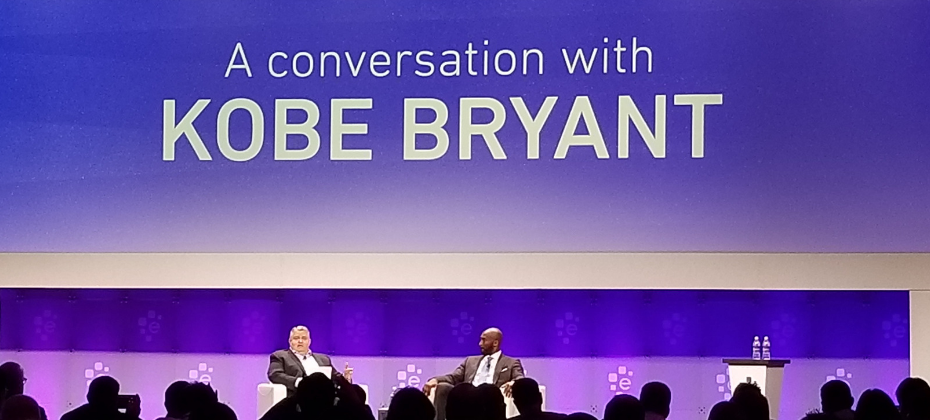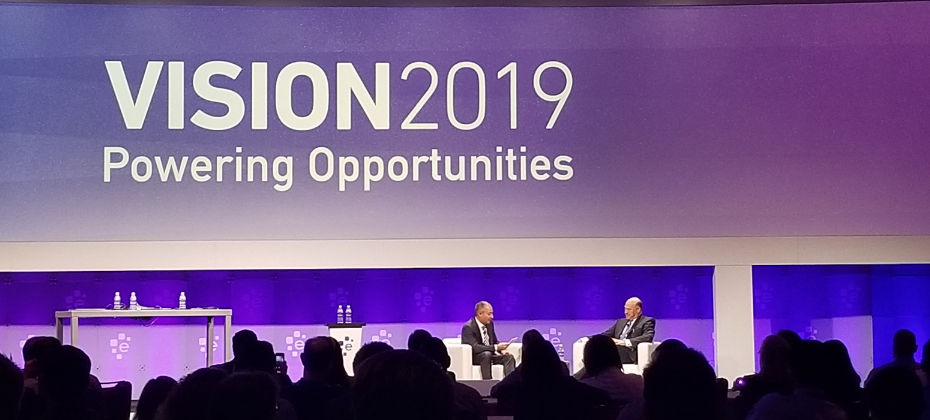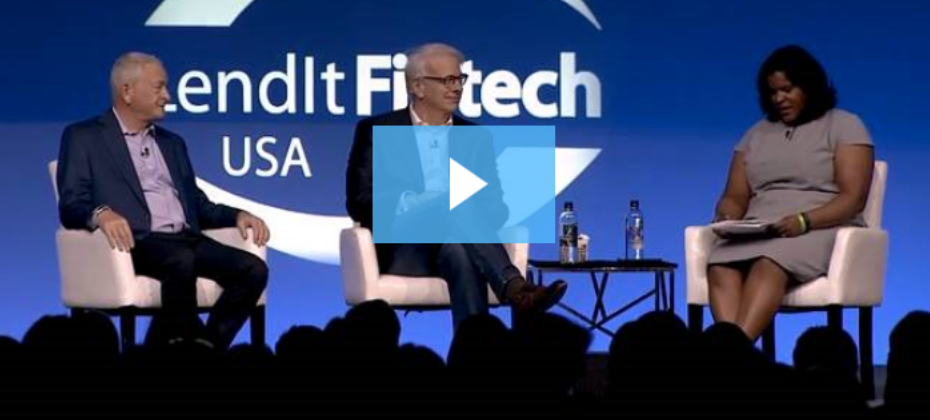Credit Lending

Day 2 at this year’s Vision conference was fueled with new technology and inspiration. The morning session opened with Robert Boxberger, Experian President, Decision Analytics, and also featured two live demos, one on Experian’s solution for the upcoming CECL compliance deadline and the second for mobile credit, including two use cases on instant issuance and lead generation, which has resulted in a 28% conversion rate of hot leads for one of Experian’s marquee clients. Keynote Speaker: Aimée Mullins "Get comfortable with the uncomfortable" was just one of the mantras shared on Tuesday morning by Aimée Mullins, an actor, Olympian, TEDTalk speaker, and one of the youngest honorees to be inducted into the National Women’s Hall of Fame, among many other accomplishments. “It is our uniqueness that’s our greatest asset that we can leverage for our greatest strength,” said Mullins during her keynote centered on achieving the “impossible.” As a bi-lateral amputee (or “double BK” also known as double below-the-knee amputee, as she referenced), Mullins had doctors and experts tell her and her parents what she would not be able to do. Instead, she encouraged Tuesday’s audience to never stop thinking like a child, to use their curiosity to find new ways where you want to go, and to practice curiosity like a sport to keep from getting comfortable, and therefore static. “It made my not knowing what I can do so much more powerful than an expert's presumption of what he thought I could do,” she said. Session Highlights – Day 2 Consumer Trust What engenders trust as consumers? And what does it take to build online trust? With 51% of new account fraud victims personally knowing the perpetrator and 3.4 billion total losses from fraudulent account openings (Javelin Feb 2019), there are five key components to building trust: digital adoption, transparency, fraud management, recognition and authentication. Today’s consumers want to use the digital channel, have both security and ease of access, be recognized, know how their personal information is being used, and engage and trust with biometrics. Artificial Intelligence – Chat Bots and Beyond According to Gartner, “'Conversational AI-first' will supersede ‘cloud-first,’ ‘mobile first’ as the most important high-level imperative for the next 10 years.” As evidenced by Google Duplex’s realistic conversations with humans, including the use of “uh” and “um,” conversational AI is positioned to redefine the next generation of human interface, aimed at achieving better customer satisfaction and elevate the customer relationship. Marketing Analytics The marketing analytics landscape is changing. Today’s marketing problems – including the always limited budget and need to produce greater ROI – require tactical strategies to target the right consumers. Enter Experian’s AscendTM marketing platform. Leveraging this tool, including its neural networks that were demonstrated Monday morning, helps gain new insights into consumer behavior. Fraud in the Digital Wild West A panel discussion featuring representatives from Merchant Risk Council, USAA and Alliance Data compared fighting fraud to herding cats. Challenges discussed included the ongoing struggle to find balance between limiting friction during the authentication process, while also protecting customers, as well as fraudsters’ tendencies to tap into victims’ emotions and curiosity (think phishing schemes). As one of the panelists offered as a piece of advice, “Fraudsters share best practices, so should we.” Visibility for the Invisibles People are more than the sum of their parts. The traditional credit score may show a consumer’s reputation, but layering trended and alternative data sets adds their character. Not only can trended data and alternative credit data – including leveraging education attributes – make invisible consumers visible, they can also reveal that a consumer with a presumably superlative credit score is actually a “credit zombie.” These data sets enable the opportunity to create first chances, drive second chances and re-evaluate risk, while also driving a strong growth strategy. CECL After reviewing the basics of CECL and the upcoming deadlines (ranging from Q1 2020 to Q1 2022), a review of CECL compliance challenges and potential product changes preceded a modeling techniques case study and a list of key impacts to businesses. Those impacts include: product profitability, loss forecasting methodology, data management and processes and capital ratios. Experian’s CECL forecasting solution leverages Experian’s extensive historical data and Ascend Analytical Sandbox. Using a best practice modeling pipeline to improve efficiency and reduce operational risks, the solution combines advanced machine learning, traditional model techniques and modeling experience to improve performance and reduce risk of overfitting. Keynote Speaker: Kobe Bryant Kobe Bryant closed out the day with stories from his highly-decorated 20-year career with the Los Angeles Lakers, some tips on trash talk and lessons in leadership. “I had to figure out how to be undeniable,” Bryant said, on competing for minutes at the start of his career. In addition to his basketball legacy, including wining five NBA championships, being named an NBA MVP, a two-time NBA Finals MVP and winning two Olympic gold medals, Bryant also launched the Kobe and Vanessa Bryant Family Foundation, hosts the Kobe Academy and has formed Kobe Inc. He’s a storyteller, an Oscar winner, and his name has become synonymous with standing for uncompromising excellence. How to be successful? “Make sure you have the right people on the team,” Bryant said. “Passionate. Borderline obsessive.” One of his key takeaways from his basketball career that translates to his leadership on and off the court happened when his pre-game and game time thinking shifted from internal to external. “You have to put yourself 2nd, 3rd, 4th…you have to put the team first,” Bryant said. For more coverage, follow #ExperianVision on Twitter or check the Experian Insights LinkedIn page.

“Experian is transforming our business from a traditional credit bureau to a true technology and software provider,” said Craig Boundy, CEO of Experian, North America, as part of his opening remarks Monday morning to kick off the 2019 Experian Vision Conference. “We are committed to working as a force of good.” Covering the themes of financial inclusion, giving consumers control of their lives and better outcomes, a digital-first society, and the latest trends in fraud and security, Boundy addressed a crowd of over 850. Alex Lintner, Experian’s Group President, gave a quick history of the past 3,000 years, from the first credit card, to the addition of wheels to a suitcase, to the iPhone and artificial intelligence. “Innovation is not invention,” Lintner said. He gave the example of the iPhone and how a tear down analysis revealed there were no new elements; however, it was the translation of an idea into a good or service that benefited everyone (as the entire audience raised their hand when asked who had a smart phone). Lintner’s mainstage presentation also featured three live demos, including how the Ascend Technology Platform takes complex model building and outputs from days and weeks to a few clicks, to the incorporation of Small Business Financial Exchange (SBFE) data into the Ascend Analytical Sandbox (incorporating more than 17 years of small business tradeline data and 150 predictive attributes) and lastly, Experian Boost, which according to a live tracker, has boosted consumer credit scores by a total of 3.2 million points, as of this morning, since its launch eight weeks ago. Keynote Speaker: Gary D. Cohn Gary D. Cohn, Former Director of the U.S. National Economic Council, was Monday morning’s keynote speaker. He weighed in on the domestic and global economy, policy issues, financial institutions’ responsibilities and some of his predictions. Cohn brought attention to the ever-changing financial services space, including new forms of encryption and the world of biometric security, calling the financial services industry the “tip of the spear” when it comes to the digitization of the world. Session Highlights - Day 1 Machine Learning From the building blocks of neural networks to artificial intelligence, machine learning has been used in the areas of financial services that do not have adverse actions – think fraud, ID, collections. As we look to harness machine learning for models and other spaces (including adverse action), it’s important to delineate descriptive data (what’s happening now); predictive data (what’s happening in the future); prescriptive data (what am I going to do now); and cognitive data (are we asking the right question?). In addition, it’s necessary to address the five advanced analytic drivers including customer experience, cost, risk and loss, growth and compliance. Home Equity & Lending US macroeconomic trends show consumer confidence is still on an upward trend. While investor confidence is a little volatile, the GDP remains strong (though slightly slowing down) and unemployment is low and forecasted to remain low. Since 2006, the US hasn’t returned in the HELOC space. Mortgage and personal loans are up 20% and 13% respectively, while mortgages have dropped 1% and HELOCs have dropped 2%. With an estimated market potential of over $700 billion, HELOCs may be an untapped credit line given the strength of the economy. Identity Evolution From dumpster divers, aka pulling receipts out of dumpsters behind businesses, to today’s identity-based authentication, there’s been an evolution of how identity is defined as well as its corresponding risks. According to Experian’s Global Fraud & Identity Report, 74% of consumers value security as the most important part of the online experience (over convenience and personalization). However, 74% of consumers abandoned a shopping session that required too much information, and 72% of consumers said they were willing to share more data if it meant a seamless experience. What does this mean? Consumers want it all. Identity today now includes proxies and activity, which can also mean greater risk. Because of aggregators and other associated entities acting on a consumer’s behalf, there are lots of nuances that will need to be looked through. Consumer-Permissioned Data In order to be more consumer-centric, there are four levers through which consumers are given control: data accuracy, knowing their financial profile, the ability to improve their scores (via Experian BoostTM and UltraFICOTM) and protecting consumers when they permission access to their identity credentials. Using Experian Boost, consumers have seen an average increase of 13 points for consumers with positive changes. Additionally, using alternative credit data, financial institutions can score more people and score more accurately. One hundred million consumers could gain greater access to credit with consumer-permissioned data sources. --- Meanwhile, the tech showcase featured over 20 demos covering alternative data, digital credit marketing, consumer empowerment, fraud and identity, integrated decisioning and technology. More insights from Vision to come. Follow @ExperianVision and #ExperianVision on Twitter to see more of the action.

Your consumers’ credit score plays an important role in how lenders and financial institutions measure their creditworthiness and risk. With a good credit score, which is generally defined as a score of 700 or above, they can quickly be approved for credit cards, qualify for a mortgage, and have easier access to loans with lower interest rates. In the spirit of Financial Literacy Month, we’ve rounded up what it takes for consumers to have a good credit score, in addition to some alternative considerations. Pay on Time Life gets busy and sometimes your consumers miss the “credit card payment due” note on their calendar squished between their work meetings and doctor’s appointment. However, payment history is one of the top factors in most credit scoring models and accounts for 35% of their credit score. As the primary objective of your consumers’ credit score is to illustrate to lenders just how likely they are to repay their debts, even one missed payment can be viewed negatively when reviewing their credit history. However, if there is a missed payment, consider checking their alternative financial services payments. They may have additional payment histories that will skew their creditworthiness more so than just their record according to traditional credit lines alone. Limit Credit Cards When your consumers apply for a new loan or credit card, lenders “pull” their credit report(s) to review their profile and weigh the risk of granting them credit or loan approval. The record of the access to their credit reports is known as a “hard” inquiry and has the potential to impact their credit score for up to 12 months. Plus, if they’re already having trouble using their card responsibly, taking on potential new revolving credit could impact their balance-to-limit ratio. For your customers that may be looking for new cards, Experian can estimate your consumers spend on all general-purpose credit and charge cards, so you can identify where there is additional wallet share and assign their credit lines based on actual spending need. Have a Lengthy Credit History The longer your consumers’ credit history, the more time they’ve spent successfully managing their credit obligations. When considering credit age, which makes up 21% of their credit score, credit scoring models evaluate the ages of your consumers’ oldest and newest accounts, along with the average age of all their accounts. Every time they open new credit cards or close an old account, the average age of their credit history is impacted. If your consumer’s score is being negatively affected by their credit history, consider adding information from alternative credit data sources for a more complete view. Manage Debt Wisely While some types of debt, such as a mortgage, can help build financial health, too much debt may lead to significant financial problems. By planning, budgeting, only borrowing when it makes sense, and setting themselves up for unexpected financial expenses, your consumers will be on the path to effective debt management. To get a better view of your consumers spending, consider Experian’s Trended3DTM, a trended attribute set that helps lenders unlock valuable insights hidden within their consumers’ credit scores. By using Trended3DTM data attributes, you’ll be able to see how much of your consumers’ credit line they typically utilize, whether they tend to revolve or transact, and if they are likely to transfer a balance. By adopting these habits and making smart financial decisions, your consumers will quickly realize that it’s never too late to rebuild their credit score. For example, they can potentially instantly improve their score with Experian Boost, an online tool that scans their bank account transactions to identify mobile phone and utility payments. The positive payments are then added to their Experian credit file and increase their FICO® Score in real time. Learn More About Experian Boost Learn More About Experian Trended 3DTM

If you’re a credit risk manager or a data scientist responsible for modeling consumer credit risk at a lender, a fintech, a telecommunications company or even a utility company you’re certainly exploring how machine learning (ML) will make you even more successful with predictive analytics. You know your competition is looking beyond the algorithms that have long been used to predict consumer payment behavior: algorithms with names like regression, decision trees and cluster analysis. Perhaps you’re experimenting with or even building a few models with artificial intelligence (AI) algorithms that may be less familiar to your business: neural networks, support vector machines, gradient boosting machines or random forests. One recent survey found that 25 percent of financial services companies are ahead of the industry; they’re already implementing or scaling up adoption of advanced analytics and ML. My alma mater, the Virginia Cavaliers, recently won the 2019 NCAA national championship in nail-biting overtime. With the utmost respect to Coach Tony Bennett, this victory got me thinking more about John Wooden, perhaps the greatest college coach ever. In his book Coach Wooden and Me, Kareem Abdul-Jabbar recalled starting at UCLA in 1965 with what was probably the greatest freshman team in the history of basketball. What was their new coach’s secret as he transformed UCLA into the best college basketball program in the country? I can only imagine their surprise at the first practice when the coach told them, “Today we are going to learn how to put on our sneakers and socks correctly. … Wrinkles cause blisters. Blisters force players to sit on the sideline. And players sitting on the sideline lose games.” What’s that got to do with machine learning? Simply put, the financial services companies ready to move beyond the exploration stage with AI are those that have mastered the tasks that come before and after modeling with the new algorithms. Any ML library — whether it’s TensorFlow, PyTorch, extreme gradient boosting or your company’s in-house library — simply enables a computer to spot patterns in training data that can be generalized for new customers. To win in the ML game, the team and the process are more important than the algorithm. If you’ve assembled the wrong stakeholders, if your project is poorly defined or if you’ve got the wrong training data, you may as well be sitting on the sideline. Consider these important best practices before modeling: Careful project planning is a prerequisite — Assemble all the key project stakeholders, and insist they reach a consensus on specific and measurable project objectives. When during the project life cycle will the model be used? A wealth of new data sources are available. Which data sources and attributes are appropriate candidates for use in the modeling project? Does the final model need to be explainable, or is a black box good enough? If the model will be used to make real-time decisions, what data will be available at runtime? Good ML consultants (like those at Experian) use their experience to help their clients carefully define the model development parameters. Data collection and data preparation are incredibly important — Explore the data to determine not only how important and appropriate each candidate attribute is for your project, but also how you’ll handle missing or corrupt data during training and implementation. Carefully select the training and validation data samples and the performance definition. Any biases in the training data will be reflected in the patterns the algorithm learns and therefore in your future business decisions. When ML is used to build a credit scoring model for loan originations, a common source of bias is the difference between the application population and the population of booked accounts. ML experts from outside the credit risk industry may need to work with specialists to appreciate the variety of reject inference techniques available. Segmentation analysis — In most cases, more than one ML model needs to be built, because different segments of your population perform differently. The segmentation needs to be done in a way that makes sense — both statistically and from a business perspective. Intriguingly, some credit modeling experts have had success using an AI library to inform segmentation and then a more tried-and-true method, such as regression, to develop the actual models. During modeling: With a good plan and well-designed data sets, the modeling project has a very good chance of succeeding. But no automated tool can make the tough decisions that can make or break whether the model is suitable for use in your business — such as trade-offs between the ML model’s accuracy and its simplicity and transparency. Engaged leadership is important. After modeling: Model validation — Your project team should be sure the analysts and consultants appreciate and mitigate the risk of over fitting the model parameters to the training data set. Validate that any ML model is stable. Test it with samples from a different group of customers — preferably a different time period from which the training sample was taken. Documentation — AI models can have important impacts on people’s lives. In our industry, they determine whether someone gets a loan, a credit line increase or an unpleasant loss mitigation experience. Good model governance practice insists that a lender won’t make decisions based on an unexplained black box. In a globally transparent model, good documentation thoroughly explains the data sources and attributes and how the model considers those inputs. With a locally transparent model, you can further explain how a decision is reached for any specific individual — for example, by providing FCRA-compliant adverse action reasons. Model implementation — Plan ahead. How will your ML model be put into production? Will it be recoded into a new computer language, or can it be imported into one of your systems using a format such as the Predictive Model Markup Language (PMML)? How will you test that it works as designed? Post-implementation — Just as with an old-fashioned regression model, it’s important to monitor both the usage and the performance of the ML model. Your governance team should check periodically that the model is being used as it was intended. Audit the model periodically to know whether changing internal and external factors — which might range from a change in data definition to a new customer population to a shift in the economic environment — might impact the model’s strength and predictive power. Coach Wooden used to say, “It isn’t what you do. It’s how you do it.” Just like his players, the most successful ML practitioners understand that a process based on best practices is as important as the “game” itself.

Earlier this month, Experian joined the nation’s largest community of online lenders at LendIt Fintech USA 2019 in San Francisco, CA to show over 5,000 attendees from 50 countries the ways consumer-permissioned data is changing the credit landscape. Experian Consumer Information Services Group President, Alex Lintner, and FICO Chief Executive Officer, Will Lansing, delivered a joint keynote on the topic of innovation around financial inclusion and credit access. The keynote addressed the analytical developments behind consumer-permissioned data and how it can be leveraged to responsibly and securely extend credit to more consumers. The session was moderated by personal finance expert, Lynnette Khalfani-Cox, from The Money Coach. “Consumer-permissioned data is not a new concept,” said Lintner. “All of us are on Facebook, Twitter, and LinkedIn. The information on these platforms is given by consumers. The way we are using consumer-permissioned data extends that concept to credit services.” During the keynote, both speakers highlighted recent company credit innovations. Lansing talked about UltraFICO™, a score that adds bank transaction data with consumer consent to recalibrate an existing FICO® Score, and Lintner discussed the newly launched Experian Boost™, a free, groundbreaking online platform that allows consumers to instantly boost their credit scores by adding telecommunications and utility bill payments to their credit file. “If a consumer feels that the information on their credit files is not complete and that they are not represented holistically as an applicant for a loan, then they can contribute their own data by giving access to tradelines, such as utility and cell phone payments,” explained Lintner. There are approximately 100 million people in America who do not have access to fair credit, because they are subprime, have thin credit files, or have no lending history. Subprime consumers will spend an additional $200,000 over their lifetime on the average loan portfolio. Credit innovations, such as Experian Boost and UltraFICO not only give consumers greater control and access to quality credit, but also expand the population that lenders can responsibly serve while providing a differentiated and competitive advantage. “Every day, our data is used in one million credit decisions; 350 million per year,” said Lintner. “When our data is being used, it represents the consumers’ credit reputation. It needs to be accurate, it needs to be timely and it needs to be complete.” Following the keynote, Experian, FICO, Finicity and Deserve joined forces in a breakout panel to dive deeper into the concept of consumer-permissioned data. Panel speakers included Greg Wright, Chief Product Officer at Experian’s Consumer Information Services; Dave Shellenberger, Vice President of Product Management at FICO; Nick Thomas, Co-Founder, President and Chief Technology Officer at Finicity, and Kalpesh Kapadia, Chief Executive Officer at Deserve. “As Alex described in today’s keynote, consumer-permissioned data is not a new concept,” said Greg Wright. “The difference here is that Experian, FICO and Finicity are applying this concept to credit services, working together to bring consumer-permissioned data to mass scale, so that lenders can reach more people while taking on less risk.” For an inside look at Experian and FICO’s joint keynote, watch the video below, or visit Experian.com and boost your own credit score.

So often a microscope is set on examining millennials and their behaviors – especially when it comes to their priorities and finances. But there’s a new generation entering the economy, with an entirely new set of preferences, behaviors and approach to money. Enter Gen Z. According to Bloomberg, this year, Generation Z becomes the biggest consumer cohort globally, “displacing millennials as a top obsession for investors.” This generation (falling between the ages of seven and 22) is 61 million strong and has a spending power of $143 billion in the U.S. alone. While much of the population that makes up Generation Z may still be in school, they are already creating their reputation as conscientious consumers. And lenders and financial institutions need to get in front of them if they want a chance at these meaningful investments. Because this generation has grown up in a world where the internet has always existed, everything can be ordered and delivered on demand, and communications occur over mobile platforms like Instagram and Snapchat, they view the world – and finances – through a different lens. Bloomberg suggests the following Gen Z broad trends; which investors should consider if they want this growing generation in their portfolios: They can be influenced. According to a recent Bloomberg survey, 52% of Gen Zers said they primarily find out about new products from social media. And they are 3 times more likely to purchase a product recommended by one of their favorite influencers than by a television or film celebrity. They have different vices – beyond just their smartphone addictions. As they are growing up in a world where screen time is eminent and cannabis is becoming legal (already legal in 10 U.S. states), they live with a different world view than many of the other generations. They don’t have to go to stores. Gen Z shops via clicks, not bricks. They choose their brand loyalties carefully. This generation is interested in environmental issues and ethical shopping, which drives their consumer activities, meaning it’s time for new considerations when it comes to marketing. They eat differently. Less likely to eat meat, we’re already seeing the shift that fast-food restaurants and packaged-food distributors are taking. What does this mean for financial institutions? You don’t have to be a social media influencer to get Gen Z in your portfolio – but it wouldn’t hurt. Many reports indicate that by 2020, Gen Z will command nearly 40% of all consumer shopping. With shopping driven by scrolling and purpose-driven purchases facilitated primarily by online transactions, gaining an understanding of these young consumers’ credit and charge card habits means you can better understand bankcard wallet share and target them as they start joining the workforce and beyond. In the not-too-distant future, there will be a need to examine high spend to increase interchange income. Trended data solutions can gain insight into these consumers as well as help you target and offer new lines of credit as they purchase with purpose – fueling them with credit to fund the ventures that matter to them most. Learn More

A court in a Northern China province has developed a mobile app designed to enforce court rulings and create a socially credible environment. The app, which can be accessed via WeChat, China's most popular instant messaging platform, is designed to alert users when they are within a 500-meter radius of someone in debt. Users will get personal information about the debtors, including their exact location, names, national ID numbers, and why they have a low score. It's the latest innovation to become integrated into China's social credit system. What is a social credit system? China's social credit system, which will be enforced in 2020, aims to standardize the social reputation of citizens and businesses. It will rank citizens by attaching a score to various aspects of their social life - ranging from paying court fees to drinking alcohol to failing to pay bills. Although there are proposed consequences for low scorers, including travel bans and loan declines, 80% of citizens recently surveyed by the Washington Post support it. While the app seems like it could be a plotline from a "Black Mirror" episode, with its emphasis on reputation scoring and location-based activation, there are reasons it makes sense for the rather remote northern province. With many people in China still not having formal access to traditional banks, being able to alternatively assess their trustworthiness and risk could provide them the ability to access loans, rent houses, and even send their children to school. Additionally, to increase their scores, Chinese citizens are displaying improved behavior. China isn't the first country to attempt to gain a robust understanding of its consumers through alternative data sources. While U.S. financial institutions have experimented with using social media as a factor in determining a borrower's risk, Philippines-based Lenddo, a world leader in scoring and identity verification technology, is doing that and more. The company looks at social media, email, and mobile headset activity to determine repayment ability. Moreover, Discovery Bank in South Africa believes there's a correlation between fiscal responsibility and physical health. The South African bank plans to begin tracking the habits of its 4.4 million customers and offering better deals to those who are living a healthier lifestyle. For example, consumers can earn points for visiting the gym, getting a flu shot, or buying healthy groceries. The more points a consumer collects the better deals and savings they'll receive. The willingness to share data is not a characteristic unique to South African or Chinese citizens. A recent Accenture study of 47,000 banking and insurance customers showed that consumers are willing to share personal data in exchange for better customer assistance and discounts on products and services. The full extent of the impact on social credit to Chinese citizens is impossible to calculate, simply because the system doesn't fully exist yet. However, it does serve as an example of the many ways that credit scoring and the use of customer-permissioned data are evolving. Long gone are the days of mailing checks, ordering from a catalog, or even needing to carry cash. What's next?

The lending market has seen a significant shift from traditional financial institutions to fintech companies providing alternative business lending. Fintech companies are changing the brick-and-mortar landscape of lending by utilizing data and technology. Here are four ways fintech has changed the lending process and how traditional financial institutions and lenders can keep up: 1. They introduced alternative lending models In a traditional lending model, lenders accept deposits from customers to extend loan offers to other customers. One way that fintech companies disrupted the lending process is by introducing peer-to-peer lending. With peer-to-peer lending, there is no need to take a deposit at all. Instead, individuals can earn interest by lending to others. Banks who collaborate with peer-to-peer lenders can improve their credit appraisal models, enhance their online lending strategy, and offer new products at a lower cost to their customers. 2. They offer fast approvals and funding In certain situations, it can take banks and credit card providers weeks to months to process and approve a loan. Conversely, fintech lenders typically approve and fund loans in less than 24 hours. According to Mintel, only 30% of consumers find various banking features easy-to-use. Financial experts at Toptal suggest that banks consider speeding up the loan application and funding process within their online lending platforms to keep up with high-tech companies, such as Amazon, that offer customers an overall faster lending process from applications to approval, to payments. 3. They're making use of data Typically, fintech lenders pull data from several different alternative sources to quickly determine how likely a borrow is to pay back the loan. The data is collected and analyzed within seconds to create a snapshot of the consumer's creditworthiness and risk. The information can include utility, rent. auto payments, among other sources. To keep up, financial institutions have begun to implement alternative credit data to get a more comprehensive picture of a consumer, instead of relying solely upon the traditional credit score. 4. They offer perks and savings By enacting smoother automated processes, fintech lenders can save money on overhead costs, such as personnel, rent, and administrative expenses. These savings can then be passed onto the customer in the form of competitive interest rates. While traditional financial institutions generally have low overall interest rates, the current high demand for loans could help push their rates even lower. Additionally, financial institutions have started to offer more customer perks. For example, Goldman Sachs recently created an online lending platform, called Marcus, that offers unsecured consumer loans with no fees. Financial institutions may feel stuck in legacy systems and unable to accomplish the agile environments and instant-gratification that today's consumers expect. However, by leveraging new data sets and innovation, financial institutions may be able to improve their product offerings and service more customers. Looking to take the next step? We can help. Learn More About Banks Learn More About Fintechs

Alternative credit data and trended data each have advantages to lenders and financial institutions. Is there such a thing as the MVD (Most Valuable Data)? Get Started Today When it comes to the big game, we can all agree the score is the last thing standing; however, how the two teams arrived at that score is arguably the more important part of the story. The same goes for consumers’ credit scores. The teams’ past records and highlight reels give insight into their actual past performance, while game day factors beyond the stat sheets – think weather, injury rehab and personal lives – also play a part. Similarly, consumers’ credit scores according to the traditional credit file may be the dependable source for determining credit worthiness. But, while the traditional credit file is extensive, there is a playbook of other, additional information you can arm yourself with for easier, faster and better lending decisions. We’ve outlined what you need to create a win-win data strategy: Alternative credit data and trended data each have unique advantages over traditional credit data for both lenders and consumers alike. How do you formulate a winning strategy? By making sure you have both powerhouses on your roster. The results? Better than that game-winning touchdown and hoisting the trophy above your head – universe expansion and the ability to lend deeper. Get Started Today

Are You #TeamTrended or #TeamAlternative? There’s no such thing as too much data, but when put head to head, differences between the data sets are apparent. Which team are you on? Here’s what we know: With the entry and incorporation of alternative credit data into the data arena, traditional credit data is no longer the sole determinant for credit worthiness, granting more people credit access. Built for the factors influencing financial health today, alternative credit data essentially fills the gaps of the traditional credit file, including alternative financial services data, rental payments, asset ownership, utility payments, full file public records, and consumer-permissioned data – all FCRA-regulated data. Watch this video to see more: Trended data, on the other hand shows actual, historical credit data. It provides key balance and payment data for the previous 24 months to allow lenders to leverage behavior trends to determine how individuals are utilizing their credit. Different splices of that information reveal particular behavior patterns, empowering lenders to then act on that behavior. Insights include a consumer’s spend on all general purpose credit and charge cards and predictive metrics that identify consumers who will be in the market for a specific type of credit product. In the head-to-head between alternative credit data and trended data, both have clear advantages. You need both on your roster to supplement traditional credit data and elevate your game to the next level when it comes to your data universe. Compared to the traditional credit file, alternative credit data can reveal information differentiating two consumers. In the examples below, both consumers have moderate limits and have making timely credit card payments according to their traditional credit reports. However, alternative data gives insight into their alternative financial services information. In Example 1, Robert Smith is currently past due on his personal loan, whereas Michelle Lee in Example 2 is current on her personal loan, indicating she may be the consumer with stronger creditworthiness. Similarly, trended data reveals that all credit scores are not created equal. Here is an example of how trended data can differentiate two consumers with the same score. Different historical trends can show completely different trajectories between seemingly similar consumers. While the traditional credit score is a reliable indication of a consumer’s creditworthiness, it does not offer the full picture. What insights are you missing out on? Go to Infographic Get Started Today

Experian Boost gives consumers greater control over their credit profiles by allowing them to add non-traditional credit information to their Experian credit file.

With scarce resources and limited experience available in the data science field, a majority of organizations are partnering with outside firms to fill gaps within their teams. A report compiled by Hexa Research found that the data analytics outsourcing market is set to expand at a compound annual growth rate of 30 percent between 2016 and 2024, reaching annual revenues of more than $6 billion. With data science becoming a necessity for success, outsourcing these specific skills will be the way of the future. When working with outside firms, you may be given the option between offshore and onshore resources. But how do you decide? Let’s discuss a few things you can consider. Offshore A well-known benefit of using offshore resources is lower cost. Offshore resources provide a larger pool of talent, which includes those who have specific analytical skills that are becoming rare in North America. By partnering with outside firms, you also expose your organization to global best practices by learning from external resources who have worked in different industries and locations. If a partner is investing research and development dollars into specific data science technology or new analytics innovations, you can use this knowledge and apply it to your business. With every benefit, however, there are challenges. Time zone differences and language barriers are things to consider if you’re working on a project that requires a large amount of collaboration with your existing team. Security issues need to be addressed differently when using offshore resources. Lastly, reputational risk also can be a concern for your organization. In certain cases, there may be a negative perception — both internally and externally — of moving jobs offshore, so it’s important to consider this before deciding. Onshore While offshore resources can save your organization money, there are many benefits to hiring onshore analytical resources. Many large projects require cross-functional collaboration. If collaboration is key to the projects you’re managing, onshore resources can more easily blend with your existing resources because of time zone similarities, reduced communication barriers and stronger cultural fit into your organization. In the financial services industry, there also are regulatory guidelines to consider. Offshore resources often may have the skills you’re looking for but don’t have a complete understanding of our regulatory landscape, which can lead to larger problems in the future. Hiring resources with this type of knowledge will help you conduct the analysis in a compliant manner and reduce your overall risk. All of the above Many of our clients — and we ourselves — find that an all-of-the-above approach is both effective and efficient. In certain situations, some timeline reductions can be made by having both onshore and offshore resources working on a project. Teams can include up to three different groups: Local resources who are closest to the client and the problem Resources in a nearby foreign country whose time zone overlaps with that of the local resources More analytical team members around the world whose tasks are accomplished somewhat more independently Carefully focusing on how the partnership works and how the external resources are managed is even more important than where they are located. Read 5 Secrets to Outsourcing Data Science Successfully to help you manage your relationship with your external partner. If your next project calls for experienced data scientists, Experian® can help. Our Analytics on DemandTM service provides senior-level analysts, either offshore or onshore, who can help with analytical data science and modeling work for your organization.

2019 is here — with new technology, new regulations and new opportunities on the docket. What does that mean for the financial services space? Here are the five trends you should keep your eye on and how these affect your credit universe. 1. Credit access is at an all-time high With 121 million Americans categorized as credit-challenged (subprime scores and a thin or nonexistent credit file) and 45 million considered credit-invisible (no credit history), the credit access many consumers take for granted has appeared elusive to others. Until now. The recent launch of Experian BoostTM empowers consumers to improve their credit instantly using payment history from their utility and phone bills, giving them more control over their credit scores and making them more visible to lenders and financial institutions. This means more opportunities for more people. Coupled with alternative credit data, which includes alternative financial services data, rental payments, and full-file public records, lenders and financial institutions can see a whole new universe. In 2019, inclusion is key when it comes to universe expansion goals. Both alternative credit and consumer-permissioned data will continue to be an important part of the conversation. 2. Machine learning for the masses The financial services industry has long been notorious for being founded on arguably antiquated systems and steeped in compliance and regulations. But the industry’s recent speed of disruption, including drastic changes fueled by technology and innovation, may suggest a changing of the guard. Digital transformation is an industry hot topic, but defining what that is — and navigating legacy systems — can be challenging. Successfully integrating innovation is the convergence at the center of the Venn diagram of strategy, technology and operations. The key, according to Deloitte, is getting “a better handle on data to extract the greatest value from technology investments.” How do you get the most value? Risk managers need big data, machine learning and artificial intelligence strategies to deliver market insights and risk evaluation. Between the difficulty of leveraging data sets and significant investment in time and money, it’s impossible for many to justify. To combat this challenge, the availability and access to an analytical sandbox (which contains depersonalized consumer data and comparative industry intel) is crucial to better serve clients and act on opportunities in lenders’ credit universe and beyond. “Making information analysis easily accessible also creates distinct competitive advantages,” said Vijay Mehta, Chief Innovation Officer for Experian’s Consumer Information Services, in a recent article for BAI Banking Strategies. “Identifying shifts in markets, changes in regulations or unexpected demand allows for quick course corrections. Tightening the analytic life cycle permits organizations to reach new markets and quickly respond to competitor moves.” This year is about meaningful metrics for action, not just data visualization. 3. How to fit into the digital-first ecosystem With so many things available on demand, the need for instant gratification continues to skyrocket. It’s no secret that the financial services industry needs to compete for attention across consumers’ multiple screens and hours of screen time. What’s in the queue for 2019? Personalization, digitalization and monetization. Consumers’ top banking priorities include customized solutions, omnichannel experience improvement and enhancing the mobile channel (as in, can we “Amazonize” everything?). Financial services leaders’ priorities include some of the same things, such as enhancing the mobile channel and delivering options to customize consumer solutions (BAI Banking Strategies). From geolocation targeting to microinteractions in the user experience journey to leveraging new strategies and consumer data to send personalized credit offers, there’s no shortage of need for consumer hyper-relevance. 33 percent of consumers who abandon business relationships do so because personalization is lacking, according to Accenture data for The Financial Brand. This expectation spans all channels, emphasizing the need for a seamless experience across all devices. 4. Keeping fraudsters out Many IT professionals regard biometric authentication as the most secure authentication method currently available. We see this technology on our personal devices, and many companies have implemented it as well. Biometric hacking is among the predicted threats for 2019, according to Experian’s Data Breach Industry Forecast, released last month. “Sensors can be manipulated and spoofed or deteriorate with too much use. ... Expect hackers to take advantage of not only the flaws found in biometric authentication hardware and devices, but also the collection and storage of data,” according to the report. 5. Regulatory changes and continued trends Under the Trump Administration, the regulatory front has been relatively quiet. But according to the Wall Street Journal, as Democrats gain control of the House of Representatives, lawmakers may be setting their sights on the financial services industry — specifically on legislation in response to the credit data breach in 2017. The Democratic Party leadership has indicated that the House Financial Services Committee will be focused on protecting consumers and investors, preserving sector stability, and encouraging responsible innovation in financial technology, according to Deloitte. In other news, the focus on improving accuracy in data reporting, transparency for consumers in credit scoring and other automated decisions can be expected to continue. Consumer compliance, and specifically the fair and responsible treatment of consumers, will remain a top priority. For all your needs in 2019 and beyond, Experian has you covered. Learn more

With the new year just days behind us, and as the uptick in holiday spending comes back down, debt consolidation will take precedence along with the making (and breaking) of new year’s resolutions. Personal loans were the fastest growing unsecured lending product for much of last year. From debt consolidation to major purchases, consumers are increasingly choosing these flexible, easy-access loans over credit cards throughout the course of the year. Recent Experian research highlighted the trends around this fast-paced lending product: Previously, while industry experts had predicted a leveling off of personal loans originations, Experian data shows steady growth. Additionally, there were 35.7 million personal loan trades in the second quarter, the highest number to date since Q1 of 2007. What is driving this growth? Observations suggest growth trends across the industry as a whole – not just in the personal loans segment. And the numbers prove it. Growth is occurring across the board. Experian statistics show: Consumer confidence is up 5.6% year over year Investor confidence remains high – up 18% year over year since 1987 Unemployment remains low and continued decrease is forecasted in the near future With increased confidence and increased spending often comes increased personal loans. More financial institutions are bringing personal loans under their roofs. As many consumers enter each new year as part of a “debt consolidation nation” per se, focus for many will be on personal loans as they seek to consolidate revolving debt. Since this is a known trend, lenders across the board – from traditional financial institutions to fintechs – need to be strategic with their marketing efforts in order to reach the right consumers with the right products at the right time. Consumers consider important factors in choosing the lender(s) for their personal loans including interest rate and the ability to apply online among others. These factors see differences across generations as well. These factors and others should influence lenders’ marketing strategies, on top of their best practices. Experian partnered with Mintel Group for their insights on the 2019 trends and best practices for digital credit marketing. Register for our upcoming webinar to learn more about Digital Credit Marketing 2019 Trends and Best Practices. Register for the Webinar

What if you had an opportunity to boost your credit score with a snap of your fingers? With the announcement of Experian BoostTM, this will soon be the new reality. As part of an increasingly customizable and instant consumer reality in the marketplace, Experian is innovating in the space of credit to allow consumers to contribute information to their credit profiles via access to their online bank accounts. For decades, Experian has been a leader in educating consumers on credit: what goes into a credit score, how to raise it and how to maintain it. Now, as part of our mission to be the consumer’s bureau, Experian is ushering in a new age of consumer empowerment with Boost. Through an already established and full-fledged suite of consumer products, Experian Boost is the next generation offering a free online platform that places the control in the consumers’ hands to influence their credit scores. The platform will feature a sign-in verification, during which consumers grant read-only permission for Experian Boost to connect to their online bank accounts to identify utility and telecommunications payments. After they verify their data and confirm that they want the account information added to their credit file, consumers will receive an instant updated FICO® Score. The history behind credit information spans several centuries from a group of London tailors swapping information on customers to keeping credit files on index cards being read out to subscribers over the telephone. Even with the evolution of the credit industry being very much in the digital age today, Experian Boost is a significant step forward for a credit bureau. This new capability educates the consumer on what types of payment behavior impacts their credit score while also empowering them to add information to change it. This is a big win-win for consumers and lenders alike. As Experian is taking the next big step as a traditional credit bureau, adding these data sources is a new and innovative way to help consumers gain access to the quality credit they deserve as well as promoting fair and responsible lending to the industry. Early analysis of Experian’s Boost impact on the U.S. consumer credit scores showed promising results. Here’s a snapshot of some of those findings: These statistics provide an encouraging vision into the future for all consumers, especially for those who have a limited credit history. The benefit to lenders in adding these new data points will be a more complete view on the consumer to make more informed lending decisions. Only positive payment histories will be collected through the platform and consumers can elect to remove the new data at any time. Experian Boost will be available to all credit active adults in early 2019, but consumers can visit www.experian.com/boost now to register for early access. By signing up for a free Experian membership, consumers will receive a free credit report immediately, and will be one of the first to experience the new platform. Experian Boost will apply to most leading consumer credit scores used by lenders. To learn more about the platform visit www.experian.com/boost.